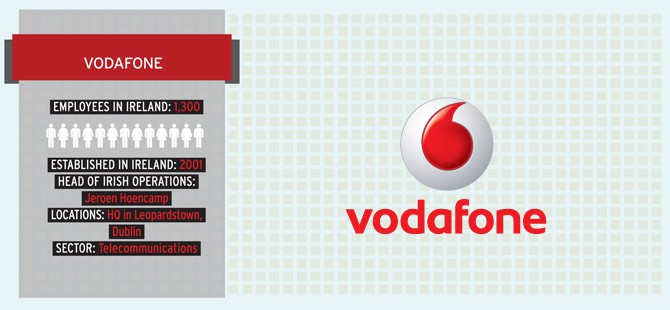Still the dominant player in the market, the number of customers using smart phones on the network has risen 56% per annum.
Eleven years after entering the Irish market and 27 years after the launch of Eircell, the company it acquired to enter the Irish market, Vodafone, remains the leading mobile provider in Ireland, with 2.2 million customers. Vodafone has maintained this position and become one of the country’s most recognised brands, all while operating in an extremely competitive environment.
Vodafone’s deal to acquire Eircell from Eircom in 2001 was the largest deal ever in Irish corporate history, given Eircell’s huge expansion in the late 1990s, as mobile telephony was embraced in Ireland. Esat Digifone had already been established prior to Vodafone’s acquisition and in the years since, a number of new players have entered the Irish market. Despite this, the dominant legacy remains and Vodafone has managed to retain its position as the number one player.
To maintain this position, the ultra fast- paced development in the telecommunications sector, Vodafone Ireland has had to adapt its strategy without moving away from the base that has given it its advantage. In a breakdown of its consumer base released in July, Vodafone Ireland says that the number of customers using smart phones on its network has increased by 56% year-on-year, to 823,000.
Vodafone employs approximately 1,300 people in Dublin and Dundalk, almost half of whom work in customer care roles. The company has invested heavily in building and maintaining its mobile networks and has made significant investment in developing 3G services in Ireland as part of a €1bn investment programme. This investment is currently being directed by Vodafone Ireland CEO Jeroen Hoencamp, who took up the position in July 2010. The role was previously held by Charles Butterworth who returned to the Vodafone group in the UK. Hoencamp joined from Vodafone Netherlands, where he was director of enterprise since 2006 and a member of the general management board for the last six years.
On foot of being the largest mobile operator in the country, last month Vodafone committed to paying €280mn to the telecoms regulator, Comreg, to secure the rights to use new digital spectrum bands that will be used to develop 4G services and broadband across the country. The new 4G rollout across all mobile networks is seen as a vital step in driving the economy and in particular giving increased broadband access to the SME sector.
Despite Vodafone Ireland’s share of the mobile market here, in the most recent half-yearly statement, the larger Vodafone Group detailed how the economic downturn has affected the Irish market. Unsurprisingly, the figures show that the Vodafone Group’s markets in Greece, Ireland, Italy, Portugal and Spain are the most directly impacted by the current market conditions.
The larger Vodafone Group is the world’s second-largest mobile telecommunications company worldwide. As of December last year, the group had 440 million subscribers worldwide, behind only China Mobile in terms of sheer numbers.
For the 12 months ending in March 2012, the Vodafone Group produced total revenue of £46.4bn and gross profit of £14.87bn. It is a truly global company, operating networks in over 30 countries and having partner networks in over 40 additional countries. Its Vodafone Global Enterprise division provides telecommunications and IT services to corporate clients in over 65 countries. Vodafone also owns 45% of Verizon Wireless, the largest mobile telecommunications company in the United States measured by subscribers.
In 2007, Vodafone Ireland entered the fixed line and broadband sector by purchasing the fixed line and broadband operator Perlico in a deal that valued Perlico at €80mn. Perlico retained its management and branding but became a wholly-owned Vodafone subsidiary. The most recent management statement for Vodafone Ireland showed that the company is managing to grow its fixed line voice, and broadband performed particularly well, reaching 241,000 at the end of the second quarter of this year, a 9.3% year-on-year increase adding 21,000 customers on the same quarter last year.

